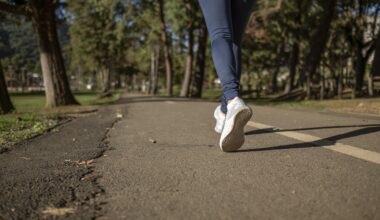Integrating Mobility Work into Daily Tennis Practice
For tennis players, incorporating effective mobility work into daily routines is crucial. Achieving optimal performance on the court requires flexibility and mobility to execute shots consistently and reduce the risk of injuries. Tennis involves rapid lateral movements, powerful serves, and quick changes in direction, all of which demand a high level of physical adaptability. Integrating mobility workouts before and after regular practices helps enhance joint range of motion and prevents tension buildup in muscles. Players can start with dynamic stretches targeting the hips, shoulders, and spine, as these areas are essential for optimal athletic performance in tennis. Specific exercises like arm circles and leg swings effectively prepare the body for action. Moreover, incorporating static stretching post-training aids in recovery. During mobility sessions, players should focus on proper techniques to maximize these exercises’ benefits. Gradually increasing the intensity and complexity of workouts leads to enhanced capabilities over time, thus improving game performance. Athletes should track their progress, adjusting their routines for best results. A consistent and tailored mobility regimen is vital for getting the best out of your tennis practice and maintaining peak performance throughout the season.
In tennis, enhancing flexibility is vital for injury prevention and performance improvement. Dynamic stretching is key to improving joint mobility, and it allows for smoother movements across the court. For example, players can perform walking lunges to improve hip flexibility and stability. Additionally, high knees and butt kicks can help warm up the body and prepare muscles for strenuous activities. It is essential to ensure that mobility and flexibility training is performed regularly, not just on practice days but throughout the week. Incorporating these exercises into daily conditioning routines pays off significantly. Moreover, recognizing specific areas that need extra attention, like hip flexors or shoulder muscles, allows for a more focused approach. Players should consult coaches or physical therapists for tailored recommendations. Having a structured routine, perhaps divided into morning and evening sessions, helps maintain consistency in training. As flexibility improves, athletes will notice enhanced ability to reach and recover from their strokes. The overall confidence gained from improved mobility directly correlates with performance satisfaction and mental well-being on the court. Players who master these aspects will ultimately elevate their game and achieve remarkable advancements.
The Importance of Recovery and Flexibility
The role of recovery cannot be overlooked when discussing mobilizing flexibility for tennis players. Recovery days are as critical as training days because they allow the body time to heal and adapt. During these recovery periods, players should engage in gentle mobility exercises such as yoga or foam rolling. These practices help alleviate muscle soreness and promote relaxation in tense areas. Emphasizing proper breathing techniques during these sessions enhances relaxation. Implementing routines that include active stretching can also be beneficial, as they stimulate blood flow and support muscle recovery. Furthermore, hydration plays a significant role in flexibility, as hydrated muscles perform better, thus preventing stiffness or injury. Tennis players should consistently drink water throughout the day and consider electrolyte replenishment after vigorous practice. Listening to one’s body is essential; if soreness persists, adjust activities accordingly. Players might evaluate their flexibility goals while integrating essential recovery practices into daily life. This proactive approach not only fosters growth but also promotes longevity within the sport. When recovery and flexibility are prioritized, athletes foster an environment where they can train harder and minimize the risk of injuries.
Incorporating mobility and flexibility exercises into daily tennis practices can be a systematic and enjoyable process. Players might establish a specific warm-up routine that includes mobility drills before each practice session. For instance, an emphasis on dynamic stretches such as torso twists or lateral lunges can set the tone for proper movement during actual gameplay. It is beneficial to set aside dedicated time both before and after practice for flexibility work. During the cooldown phase after training, players can perform static stretches targeting major muscle groups used in tennis, like quads, hamstrings, and calves. Beyond physical benefits, integrating these exercises can enhance mental focus and connection between the mind and body. The set routine can assist players in setting achievable flexibility goals, providing a clear framework for improvement. Imagining oneself executing various shots effortlessly can help reinforce the positive effects of mobility in practice. Collaborating with teammates during stretching exercises can also foster camaraderie while ensuring efforts remain consistent. Players should not overlook the effect mobility training has on enhancing overall athletic performance and developing personal resilience as a competitive athlete in tennis.
Utilizing Resources and Tools
For tennis players looking to make the most out of their mobility and flexibility training, various resources can prove helpful. Online platforms, such as video tutorials or mobile applications, provide insightful demonstrations of effective exercises specifically targeted at improving flexibility for athletes. Additionally, incorporating resistance bands can significantly enhance stretching routines and increase effectiveness. Bands allow players to work through their range while providing the necessary tension to develop strength and control during movements. Local tennis clubs often offer group sessions aimed at improving flexibility and mobility through supervised routines. These settings provide players with effective guidance from experienced trainers while promoting community and motivation. Infusing yoga classes that focus on sport-specific flexibility can also help athletes diversify their training. It is essential to find resources catering to individual needs and help players stay engaged and committed to their flexibility journey. By utilizing these available resources, players not only foster personal growth but also enjoy a broader perspective on their training routines. Ultimately, the investment in these aspects plays a vital role in shaping their comprehensive performance on the court.
Nutrition also contributes significantly to flexibility and mobility for tennis players. Maintaining a well-rounded diet rich in antioxidants, proteins, and healthy fats can enhance recovery and overall performance. Consuming specific nutrient-dense foods helps support muscle health and encourages flexibility. For example, foods high in omega-3 fatty acids, found in salmon or walnuts, help combat inflammation, ultimately supporting mobility practices. Therefore, a balanced diet directly influences recovery times and flexibility ranges. Additionally, players should consider consulting with a sports nutritionist for personalized meal plans that cater to their unique needs. Proper nutrition allows players to recover more effectively as they train harder, leading to significant performance improvements. It is essential to remember that hydration complements nutrition; thus, fluid intake must be sufficient to support your efforts. Players should also develop a nutrition strategy that accounts for pre- and post-training meals. Pre-training meals should focus on energy supply, while post-training meals serve to replenish lost nutrients. Monitoring your diet plays a crucial role in your ability to enhance mobility and subsequently optimize your tennis practice.
Conclusion
In summary, integrating mobility work into daily tennis practice serves as an undeniable imperative for both performance enhancement and injury prevention. Tennis players stand to gain a multitude of benefits by prioritizing flexibility and adopting practical strategies in their routines. Developing targeted workout plans that prioritize mobility consistently helps ensure optimal joint function and muscle elasticity. Players who focus on systematic stretching, dedicated recovery, and proper nutrition create an environment primed for improvement. Moreover, utilizing available resources elevates training effectiveness and helps sustain motivation levels. Incorporating variations in mobility training keeps the sessions engaging and supports overall athletic development. Consistency is paramount; setting regular schedules fosters accountability and allows players to witness tangible progress. As mobility and flexibility become integral components of daily practice, players will embrace significant improvements in their abilities on the court. Ultimately, elevating one’s game and ensuring longevity in sport hinges upon this synergy between mobility work and regular practice. The integration of these practices can elevate a player’s skill and confidence, translating into successful performances during matches, reinforcing satisfaction within this sport.


